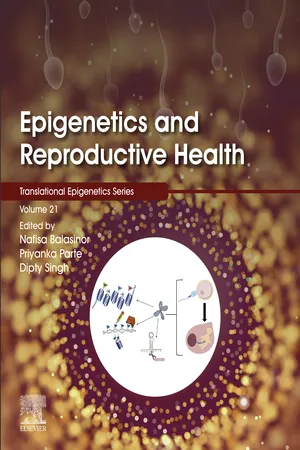
- 444 pages
- English
- ePUB (mobile friendly)
- Available on iOS & Android
Epigenetics and Reproductive Health
About this book
Epigenetics and Reproductive Health, a new volume in the Translational Epigenetics series, provides a thorough overview and discussion of epigenetics in reproduction and implications for reproductive medicine. Twenty international researchers discuss epigenetic mechanisms operating during the formation of male and female gametes, fertilization and subsequent embryo and placental development, particularly in mammals and transgenerational epigenetic inheritance. This volume also addresses aberrant epigenetic changes influencing male and female infertility, pregnancy related disorders, and those potentially linked to therapeutic manipulations and assisted reproductive technologies. Emphasis is placed on identifying biomarkers for early detection of aberrant epigenetic mechanisms.Later chapters examine the possibility of correcting these epigenetic dysfunctions, as well as current challenges and next steps in research, enabling new translational discoveries and efforts towards developing therapeutics.- Thoroughly examines the influence of aberrant epigenetics during gametogenesis and embryogenesis, affecting parents, gametes and embryos, offspring and future generations- Explores health outcomes for reproductive senescence, endocrine disruption, testicular cancer, prostrate cancer, breast cancer, ovarian, cancer, endometrial cancer and cervical cancers- Features chapter contributions from international researchers in the field
Frequently asked questions
- Essential is ideal for learners and professionals who enjoy exploring a wide range of subjects. Access the Essential Library with 800,000+ trusted titles and best-sellers across business, personal growth, and the humanities. Includes unlimited reading time and Standard Read Aloud voice.
- Complete: Perfect for advanced learners and researchers needing full, unrestricted access. Unlock 1.4M+ books across hundreds of subjects, including academic and specialized titles. The Complete Plan also includes advanced features like Premium Read Aloud and Research Assistant.
Please note we cannot support devices running on iOS 13 and Android 7 or earlier. Learn more about using the app.
Information
Chapter 14: Testicular and prostate cancers
Abstract
Keywords
Introduction
Male reproductive cancers
Testicular cancer
Table of contents
- Cover image
- Title page
- Table of Contents
- Translational Epigenetics Series
- Dedication
- Copyright
- Contributors
- Acknowledgment
- Introduction to epigenetics: basic concepts and advancements in the field
- Section I. Spermatogenesis, oogenesis and fertility
- Section II. Pregnancy/ developmental/ placental epigenetics
- Section III. Epigenetic e lifestyle, aging and environmental influence
- Section IV. Reproductive cancer and epigenetics
- Section V. Epigenetics in diagnosis, prognosis and therapy
- Index